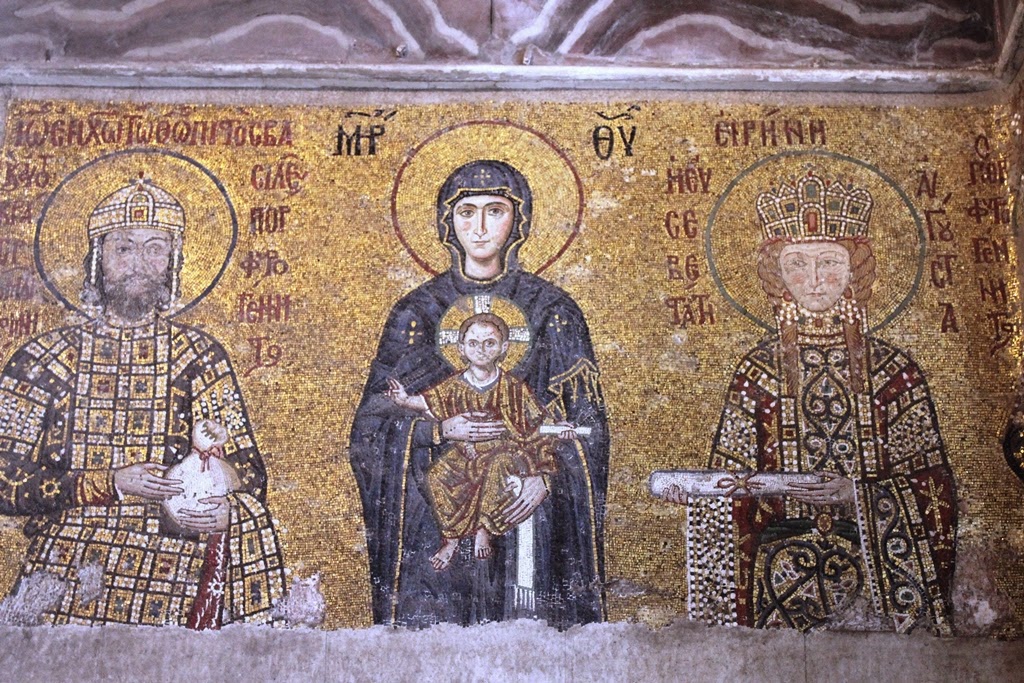Before going to Istanbul, I had gotten advice from several people on a few things. Everyone said, "You must visit the Hagia Sophia", but only one person said that his favorite was the Basilica Cistern. There are times when Luke and I don't listen to other people's advice because we march to our own drums in so many ways, but we listened this time! And its a good thing we did!
We started off one of our days going to the Hagia Sophia first. This former church (until 1453) and mosque (until 1935) was built in 537AD and dwarfs any other building in Istanbul. It is no longer a site for religious purposes as it is now a museum displaying its inner and outer beauty and a few pieces inside. For nearly a thousand years, the Hagia Sophia was the largest cathedral in the world.
The interior was enormous with a massive dome, and everything seemed to be made of marble. I loved all of the chandeliers that hung from the ceiling and the gold trim everywhere. The lighting was pretty terrible for picture taking, and the huge amount of scaffolding on one side did not help either. These pictures don't do it justice!
I knew the building was huge, but I didn't fully grasp that until we were on the second level. Even the ceilings on the second level were tall, and it was still a ways to go before reaching the top of the dome (wasn't possible, just making a comment). Wow!
There were a few windows open where we could peek out at the Blue Mosque.
On the second level, we found three mosaics with two being in very good shape. Apparently when the cathedral became a mosque, the mosaics were considered inappropriate and then covered with plastic rather than being destroyed. The second picture below is what the first picture used to look like.
On the way out of the Hagia Sophia, there was one other popular area - the Weeping Column made of copper with a worn hole in it. Legend has it that the pillar was blessed by St. Gregory the Miracle Worker. If one puts his/her finger in the hole and it emerges moist, it will lead to ailments being healed. Sounds pretty neat, but also one of the grossest things in the world, so we skipped it and watched other people stick their finger in this hole.
On to the Basilica Cistern! The cisterns were built in 532AD, and stored over 80,000 cu.meters of water from a reservoir near the Black Sea. It was used to serve the emperor at the Great Palace and other buildings nearby. When the emperor relocated, the cisterns were no longer needed and were eventually forgotten.
It wasn't until 1545, when local residents informed a city authority that they could bring water up into their homes by dropping buckets into a hole in the ground, occasionally catching a fish.
Sadly, after the rediscovery, the cisterns were used as a dumping ground for many things including corpses. It wasn't until 1985 that the Basilica Cistern was cleaned and renovated, and finally opened to the public in 1987. Apparently, there are 336 columns in the Basilica Cistern!
As we walked through, we felt drops of water occasionally fall on our heads, and saw signs warning of wet grounds on the planked walkway - it was definitely slippery! More random than fish swimming in this underground pool were two Medusa heads.
After following the signs, we saw an upside down Medusa head and a sideways Medusa head both at the bottom of separate columns. We did the best we could, but since it was so dark, our pictures were pretty awful (someone needs to learn how to use the camera properly! ahem!).
We tried to take pictures of each other too, but we ended up looking like scary monsters with horrible shadows on our faces. Anyway, the cisterns was really neat and it was a fairly inexpensive attraction to visit - always a positive in my book!
I mentioned in a previous post about us visiting a rooftop terrace and getting a great view of the Hagia Sophia. I couldn't go without showing you one picture :-)
Other posts from Istanbul: Galata Tower, Beyoğlu, The Mosques, Hagia Sophia & Basilica Cistern, Topkapi Palace, The Bazaars & Galata Bridge, Kariye Museum & Theodosian Wall, Bosphorus & Golden Horn, Kadıköy
RANDOM FACT:
The dome of the Hagia Sophia was originally covered in mosaics, but during restoration in 1847, the decoration changed to calligraphy.



































No comments:
Post a Comment